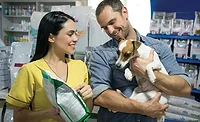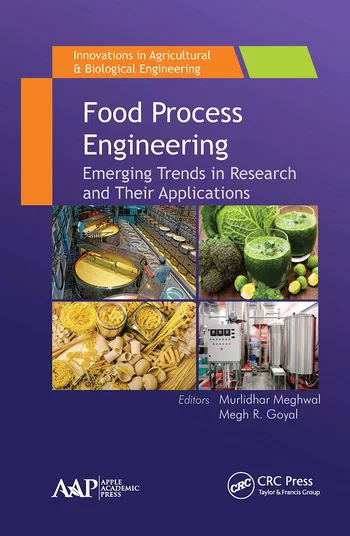Pet Food
Packaging trends in pet food production
Packaging is king in the growing market for premium dog and cat food
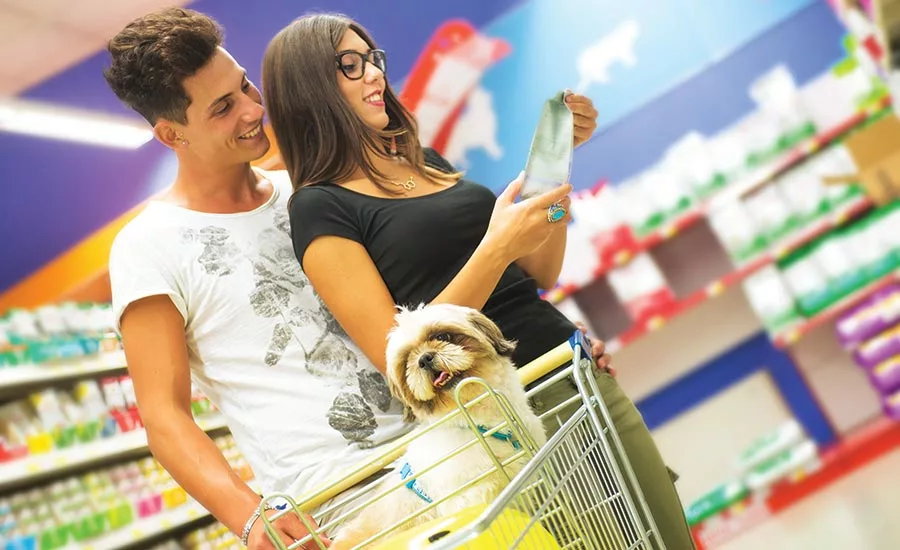
Pet food shoppers, especially people seeking premium products, are paying more for packaging that’s more sustainable, has an upscale look, or comes with convenience and freshness features.
Photo courtesy of Getty Images
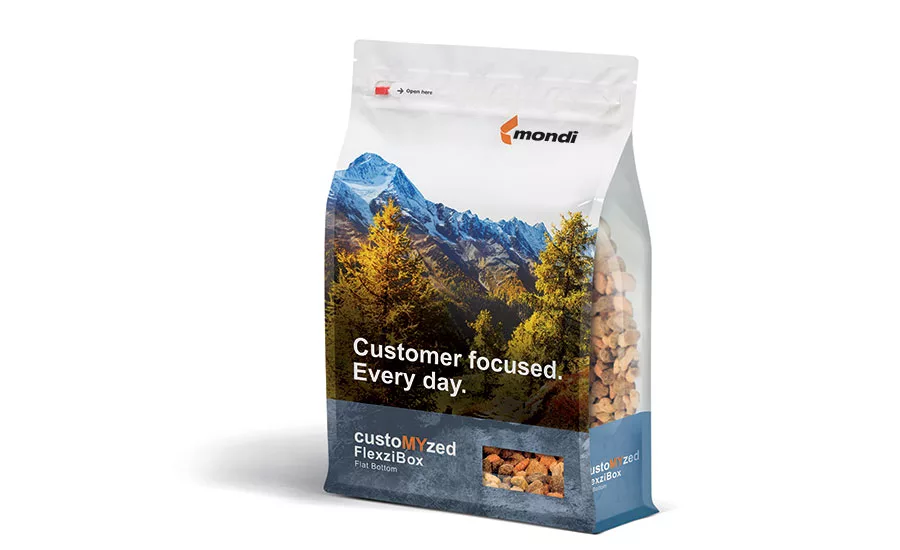
Ultra-high definition flexographic printing capability from Mondi offers rotogravure-level image quality.
Photo courtesy of Mondi Consumer Packaging
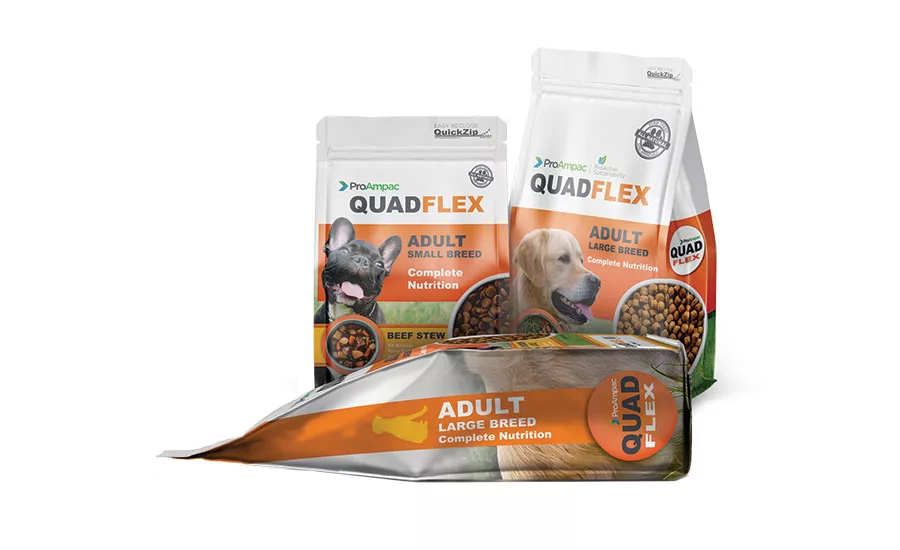
ProAmpac’s premium pet food solution, QuadFlex, has a quad-seal design with ideal shape, strength and shelf presence, along with plenty of branding space. The company recently introduced a recyclable version.
Photo courtesy of ProAmpac

Packaging scored prominently on five occasions when Mondi and Dow Chemical asked buyers of premium dry pet food about important features.
Chart courtesy of Mondi Consumer Packaging
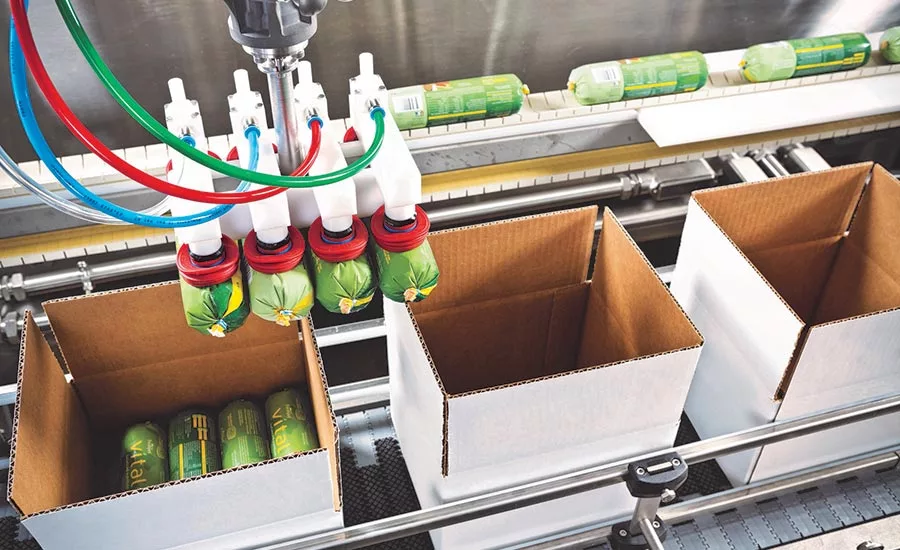
The JLS Automation case loader uses robotic pick-and-place to load products into packages and packages into cases.
Photo courtesy of Reiser
Packaging has a key role in the pet food industry’s robust growth, especially for premium products. The bag or container enables manufacturers to stand out with cat and dog owners who want sustainable options, personalized pet diets and ingredients that even humans find appealing. (Think Texas BBQ flavor.)
Shoppers have shown they are willing to pay more for sustainable packaging and convenience features like handles and stay-fresh zippers. When you buy your beloved dog or cat the best food you can afford, you really don’t want it to get stale or spill from an open bag.
Flexible packages and lighter containers with premium protection and HD printing help processors tap into booming pet ownership and react to trends like wet treats, high protein content and CBD supplements. As U.S. pet food production has become safer under FSMA, packaging reflects transparency, showing the food through windows and highlighting natural ingredients.
Bill Kuecker, vice president of marketing, Mondi Consumer Packaging, says people are increasingly assigning animals human characteristics and that has played a role in the market for pet food and its packaging.
“As the social contract changed and treating a pet as a true family member has become more of a social norm, growth and development of the premium pet food category have emerged as a natural outcome,” he says. “With the tremendous growth of premiumization, the entry of new brand players and a SKU explosion have triggered seismic packaging shifts across the pet food industry.”
Owners take their pets’ wellness extremely seriously, and that means consumers are willing to invest more in their pets’ food. As consumers are becoming informed in the science behind pet nutrition, brands are increasingly offering fresher, higher quality ingredients. In turn, this has led to the expansion of premium and specialty pet food options with many new SKUs hitting the shelves of premium pet retails and mass grocery stores, Kuecker says.
Maria Halford, vice president of global marketing, ProAmpac, says many pet owners enjoy participating in preparing their pet’s meals, just as they prefer to “finish” meals at home for their families instead of only serving prepared foods, she says.
To that end, there’s been a rise in packaging solutions for high-protein content, refrigerated and frozen options, as well as “gravy toppers” for dry kibble, she says. “As the food ingredients improve, the packaging needs to adapt.”
For example, shelf life, moisture, grease, flavor and density are all critical factors in engineering the packaging material structure. Beyond the material, packaging format is also a key differentiator, she says.
Distribution, retail facing, portability, dispensing and reclose are important factors contributing to the design of the packaging format. For example, where polywoven bags work well for large packages of dry kibble, a reclose quad-seal bag is more appropriate for a premium product being displayed on a store shelf.
Innovation is key for brand owners and consumers who are more discerning than ever, she says. They want anything from materials that run faster on filling equipment, to options that offer increased convenience, dispensing and ease of use, to recyclable and sustainable options. “As the pet food industry continues to grow, so do the demands on packaging companies to offer differentiated and functional solutions,” she says.
What Brands Want
With so many different pet food varieties on the shelves, brand owners are looking to differentiate themselves with brighter colors, high-end graphics and a variety of resealable closures, Halford says. Whether it be formats such as pouches and quad-seal bags, stand out graphics or unique finishes and printing techniques, brands are looking for that creative “pop” on the shelf.
ProAmpac has been meeting this need with its Signature Surfaces line of surface enhancements for flexible packaging materials that includes: Paper Touch, Soft Touch Matte and Registered Matte. The finishes offer visual and tactile experiences for consumers and provide brand owners additional opportunities to stand apart in the retail environment.
A Mondi survey affirms how important sustainable options are. The company teamed with Dow Chemical in 2019 to study premium pet food purchasing trends and behaviors that pet food producers can use to earn consumer preference.
About 75% of respondents “feel more favorably toward a brand with sustainable packaging,” the research found.
In today’s hyper-competitive pet food industry, brands are seeking solutions that complement their corporate values, with sustainability being a case in point, Kuecker says.
An example of this is Mondi’s BarrierPack Recyclable. The plastic laminate for premade pouches and FFS roll-stock is recyclable in areas where flexible packaging is accepted and through store drop-off. This is done without compromising the functionality.
The packaging features that brands request start with the consumer, and their preferences show the key role that packaging plays in premium pet food commerce, Kuecker says. For example, a primary finding of Mondi and Dow’s survey was in the purchasing factor category, where packaging lagged behind product quality, but was on an equal footing with brand and marginally behind price in terms of influencing purchasing behavior.
The significance of packaging in the marketing mix prompted pet food manufacturers to partner with Mondi to create pet food packaging that is easier to carry, open and reclose, and that features highly readable print, Kuecker says. Clear and readable at-a-glance print helps convey nutritional information that is of paramount importance to consumers concerned with their pets’ nutrition.
Brands are also looking for packaging that retains its functionality and consumer appeal in a demanding supply chain environment, and enables efficient manufacturing throughout the fill and ship process, he says.
Pick Your Packaging
From an operational perspective, the packaging must be compatible with the filling equipment and supply chain to meet the manufacturer’s efficiency needs. Early conversations with customers help Mondi experts navigate potential trade-offs among functionality, cost and sustainability, Kuecker says.
To help brand owners make critical packaging decisions, ProAmpac also ensures up front which designs can be commercialized in the short term on existing infrastructure and which may take more time or customized equipment to produce or fill, Halford says.
“This integrated approach helps our customers make the best decisions for their brand both thoughtfully and quickly, ensuring they stay ahead of the competition.”
ProAmpac is careful not to recommend design elements that require long lead times that are outside the brand’s launch schedules, which could include specialty filling equipment, packaging production equipment or extended drop/shelf-life testing. “Focusing our customers on readily available solutions results in faster commercialization while minimizing frustration due to complexity.”
Many innovations are centered around three basic themes: sustainability, functionality or convenience and differentiation, she says. There’s a lot of information available showing that consumers will pay more for most of these attributes.
In general, new product launches provide the opportunity for these attributes and the associated cost. It’s the products that have been in the market for a long time that make it more difficult to add features or sustainability that increase the cost, she says.
Pick Your Packaging Machine
A range of versatile packaging machines help accomplish the variety of formats for the growing pet food options. For example, Reiser’s packaging solutions cover many pet food applications, from small chubs to preformed trays with features including elaborate shapes or snap-on lids.
Reiser’s Ross line of tray sealers include startup/R&D-sized machines through the range of models to very high output applications, offering tray de-nesting, autoloading, packoff systems and more, says Mike McCann, Reiser packaging specialist.
The company also provides thermoform/fill/seal solutions through its Repak and Variovac lines, handling rigid formed packs, as well as flexible formed packs. The Reiser Rapid Air Forming systems allow the company to run all applicable film structures, creating film-saving packages, without the need for complex and expensive forming tooling, McCann says.
Films with clarity, colors, registered printed graphics, microwavability, biodegradability, various barrier combinations, peelability, zipper attachments, standup pack designs, innumerable handle style features, etc., all run simply on Reiser’s machines. “Simplicity, sustainability, greener are all of the buzz going forward on film choices,” he says.
Many “carrier packs” are in the form of zipper standup pouches with four-side graphics, handle features and other elements. Reiser can also run these using its Supervac line of inline bag sealing and evacuation systems, to streamline hand-fed systems into semiautomation.
Reiser’s JLS robotic packaging solutions are invaluable, especially for e-commerce needs, McCann says. Processors can use simplified, consolidated internal pack sizes of components (standardized to reduce changeovers) and simplified less costly films (for graphics on boxes and instruction sheets), facilitating JLS pick-and-place to load product robotically into the packs and load packs robotically into the case. This is usually done with Reiser’s thermoform/fill/seal equipment, he says.
What’s Next?
The sustainability trend will certainly continue to grow in importance, Halford says. “Brand owners are working toward greener solutions and want packaging to fill the market gap with recyclable options.”
Along with sustainability, increased functionality and shelf appeal remain important, she says. Improving the billboard on the shelf has provided growth in the company’s QuadFlex packaging.
Mondi is continuously looking for innovations that help achieve new levels of packaging cost and efficiency, within an overall framework of sustainable achievement, Kuecker says. The Mondi/Dow survey results highlight continued needs for product freshness, packaging convenience and shelf appeal.
“As brands and pet food manufacturers partner with innovative packaging companies like Mondi, consumers will enjoy more package size options and handling conveniences in recyclable or otherwise increasingly sustainable packaging,” Kuecker says. To help facilitate this, Mondi has in place EcoSolutions, its customer-centric approach that helps brands and pet food manufacturers achieve their current and future sustainability packaging goals.
“Without question, sustainability will remain a primary consideration in the design and development of pet food packaging moving forward,” he says.
Freshpet: An example of the growth that packaging makers are chasing
CRB will develop Freshpet’s third kitchen for fresh, refrigerated pet food with a design undistinguishable to human food processing lines, appealing to shoppers who want pet food that’s as safe as what they eat.

Freshpet is a prime example of the pet food market segment that focuses on natural, fresh foods that meet sustainability and safety goals.
Photo courtesy of CRB
The new facility in Ennis, Texas, will incorporate layout efficiencies, hygienic segregations, equipment, conveyance, cleaning and inspection designs that are indistinguishable from human food processing facilities, the engineering, architecture and construction company says.
The kitchen will allow Freshpet to significantly scale production capacity as buyers increasingly seek fresh and natural food for their pets. “Our third Freshpet Kitchen in Ennis is the perfect location to help us drive new innovation while making our food in a way that’s best for pets, people and the planet,” said Billy Cyr, CEO of Freshpet.
For more information:
Freshpet, www.freshpet.com
Mondi, www.mondigroup.com
ProAmpac, www.proampac.com/pet
Reiser, www.reiser.com
Looking for a reprint of this article?
From high-res PDFs to custom plaques, order your copy today!





